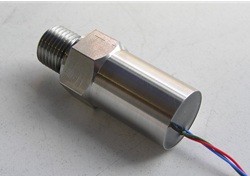
A geo-instrumentation specialist required a solution for detecting the presence of water in a 300-metre deep, normally dry borehole to protect sensitive seismic monitoring equipment. The primary challenge was integrating the transducer into an existing downhole instrument package without the use of a dedicated vented cable. The solution was a highly customised pressure transducer, configured specifically for long-term reliability in a challenging downhole environment.
- Application: Early warning water ingress detection in a deep borehole.
- Challenge: Integration into an existing instrument sonde, no separate vented cable possible.
- Solution: Compact pressure transducer with a sealed gauge reference.
- Key Feature: Fully potted electronics for maximum moisture protection.
A client specialising in the manufacture of seismic and accelerometer instrumentation for deep borehole analysis needed a reliable method to monitor for water ingress. Their sensitive equipment is often installed in boreholes up to 300 metres deep, which are expected to remain dry. The presence of water at the installation depth of 280 metres is undesirable and can lead to equipment damage, so an early warning system was required to alert them to trigger preventative maintenance.
The primary technical constraint was the need to integrate the water detection sensor directly into the main downhole instrument package, often called a sonde. This meant the sensor had to be compact and could not have its own separate cable running to the surface. This immediately ruled out the use of typical submersible hydrostatic level transducers, which almost always rely on a special cable containing a vent tube. This vent tube provides an atmospheric pressure reference, which is essential for accurate vented gauge (relative) pressure measurement, but was not feasible for this integrated sonde design.
The solution was a configurable IMP compact OEM pressure transducer. A critical feature making this product suitable was the availability of a sealed gauge (SG) pressure reference. A sealed gauge sensor is calibrated against a fixed pressure that is hermetically sealed inside the sensor during manufacturing. This design choice entirely removes the need for a vent tube and an external atmospheric reference, allowing the customer to wire the sensor internally within their sonde. While minor output fluctuations due to surface barometric pressure changes will occur, this was deemed acceptable since the sensor’s function was to act as an alarm for the presence of a significant water column, not for high-accuracy level measurement.
To withstand the downhole environment, the transducer was specified with wetted parts made from 316L stainless steel and Viton O-rings, ensuring excellent media compatibility with potential groundwater. The sensor’s core is a robust piezoresistive ceramic diaphragm, well-suited for long-term deployment. For ultimate protection against the primary risk, moisture, a special “fully potted” option was selected. This process completely encapsulates the internal microprocessor-based amplifier and electronics in a protective compound, creating a formidable barrier against moisture ingress and enhancing reliability for long-term submersion. The transducer was supplied with a short length of PVC wire, simplifying the final electrical integration inside the customer’s instrument housing. The specified 0-5V three-wire output provides a clear, strong, and stable signal compatible with most data acquisition systems. This highly tailored solution provided the client with a robust, reliable, and easily integrated sensor for protecting their critical downhole assets.

IMP Compact OEM Pressure Transducer
- Pressure Range: 0 – 300 mW SG
- Output: 0 – 5V / 3-wire
- Supply Voltage: 10 – 32V dc
- Electrical Connection: 1000mm 7/0.2 PVC wire
- Process Connection: G¼” male DIN 3852
- Process Connection Material: 316 Stainless Steel
- Seal Material: Viton
- Diaphragm Material: Aluminium Oxide
- Accuracy (NL&H): <±0.25% / Span (BFSL)
- IP Rating: N/A
- Thermal Zero Shift (TZS): < ±0.04% / Span / °C
- Media Temperature: -20 to +135°C
- Operating Temperature: -20 to +80°C
- Special Options: Fully Potted
